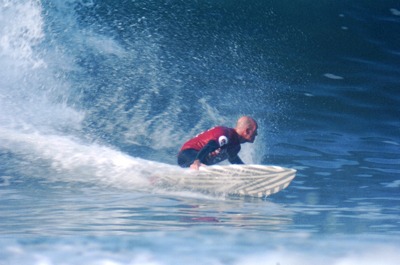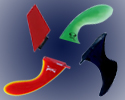New Fin Templates
Stonefish Skegs - A 3D Fin System
 The Stonefish Skeg system was developed for high performance surfing in hollow waves but has been adapted to a wide range board designs. From knee boards to longboards, tow in boards as well as performance fish designs, riders have been experimenting with the fin system and excited about the results. So what is different about Stonefish Skegs? SurfScience sat down with Randy Stockstill, the creator of the fins, to talk about his patented design. Randy stands behind his statement that, "they are more than a set of fins, they are a system which must work in conjunction with the shape of the board to create a unified wave riding vessel."
The Stonefish Skeg system was developed for high performance surfing in hollow waves but has been adapted to a wide range board designs. From knee boards to longboards, tow in boards as well as performance fish designs, riders have been experimenting with the fin system and excited about the results. So what is different about Stonefish Skegs? SurfScience sat down with Randy Stockstill, the creator of the fins, to talk about his patented design. Randy stands behind his statement that, "they are more than a set of fins, they are a system which must work in conjunction with the shape of the board to create a unified wave riding vessel."
At first look you will notice the fin has a winglet at the tip. This is a design element which a few fins have experimented with recently, but what makes the Stonefish Skeg different is how this winglet interacts with the board. Randy has designed the fins so that the winglet extends beyond the template of the board. "I surfed it exclusively for thirteen years, I would ride it, evaluate it, tweak it and try it again"
 The fins are designed to be used in a pair. By removing a center fin, drag is decreased which allows the board to be looser. The template is narrow and a bit longer but, "it increases the sensitivity so you have to be careful" says Randy. As we have discussed in another article about fin size, smaller fins will create a faster and looser fin design. Basically, these fins are made for speed, "my kneeboard flies, the thing is a rocket ship."
The fins are designed to be used in a pair. By removing a center fin, drag is decreased which allows the board to be looser. The template is narrow and a bit longer but, "it increases the sensitivity so you have to be careful" says Randy. As we have discussed in another article about fin size, smaller fins will create a faster and looser fin design. Basically, these fins are made for speed, "my kneeboard flies, the thing is a rocket ship."
So what type of surfing are these fins best for? Randy commented, "my fin is for throwing your board up on the rail, once you do that its actually like a single fin." He continued to say that the fins are best in steep conditions where the surface area of the finlet can gain traction from the water rushing up the face of the wave. This water pushes against the fin and sends the board forward
One big factor we have seen in three dimensional fins is lift. Some fins are designed to push the board out of the water by creating lift from the passing water. The Stonefish Skegs do not claim to do this. "The lifting is overplaid, there is not enough surface area at the speed surfers go to lift the tail of the board, and who would want that anyway? You would be constantly fighting from nosediving" says Randy.

The finlets are set at around 45* which allows them to work in many situations. The problem with a 90* finlet is that when a board is going straight it becomes a skidding surface as it is cutting straight through the water without resistance. That is why we have toe in on side fins. A fin going straight through water doesn't accomplish anything, it must be pushing against water to help with steering. "Toe in works like this, when you throw a board up on its rail, the angle of the toe in forces the foam in the rail down into the wave and the wave pushes back which sends you forward"
These are not plug and play fins. They are designed to be incorporated into a board design from conception. "I want people to have custom boards made, to have a board made around this steering system," says Randy, who is excited to see what can come from shapers playing around and improving on each others design.
So if you're looking to add something new to your quiver that can turn hard in steep waves, you might consider Stonefish Skegs. You can get more info from Randy's website - StonefishSkegs.com















2 Comments